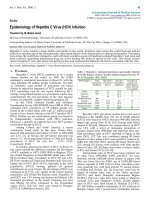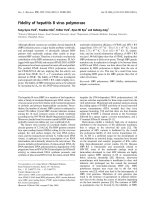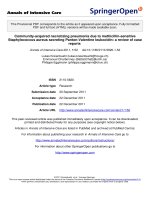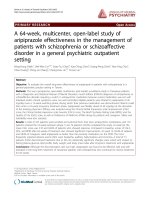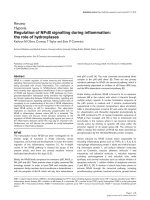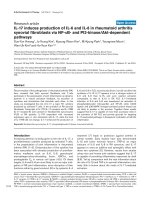Báo cáo y học: " Infection with hepatitis B virus carrying novel pre-S/S gene mutations in female siblings vaccinated at birth: two case reports" pot
Bạn đang xem bản rút gọn của tài liệu. Xem và tải ngay bản đầy đủ của tài liệu tại đây (768.07 KB, 5 trang )
JOURNAL OF MEDICAL
CASE REPORTS
Lai et al. Journal of Medical Case Reports 2010, 4:190
/>Open Access
CASE REPORT
© 2010 Lai et al; licensee BioMed Central Ltd. This is an Open Access article distributed under the terms of the Creative Commons Attri-
bution License ( which permits unrestricted use, distribution, and reproduction in any
medium, provided the original work is properly cited.
Case report
Infection with hepatitis B virus carrying novel
pre-S/S gene mutations in female siblings
vaccinated at birth: two case reports
Ming-Wei Lai
1,2
, Christopher S-H Yeh
3
and Chau-Ting Yeh*
2,3
Abstract
Introduction: After the initiation of a mass hepatitis B vaccination program in Taiwan, the prevalence of hepatitis B
virus infection has declined progressively. However, about 1 percent of the young generation, who received hepatitis B
vaccination at birth, remain carriers. Infection with vaccine-escape hepatitis B virus mutants always occurs shortly after
birth. Here, we report two female siblings in whom the infection occurred in their adolescence. This report raises the
question of whether a booster for hepatitis B vaccination is needed.
Case presentation: Two 19 and 14-year-old Taiwanese female siblings were born to a mother infected with hepatitis B
virus and received a complete course of hepatitis B vaccination at birth. They remained negative for serum hepatitis B
surface antigen and positive for serum anti-hepatitis B surface antibody throughout their childhood. However, both
were infected with the hepatitis B virus in their adolescence. Hepatitis B virus DNA was extracted from serum samples
from the mother and two siblings. Hepatitis B virus pre-S/S sequence was amplified by polymerase chain reaction
followed by nucleotide sequencing. When compared with the sequence obtained from the mother, multiple amino
acid substitutions located near or in the major hydrophilic region of the surface antigen were identified in the elder
sister. Four of these mutations (sL97S, sL98S, sG102R, and sA159P) were novel. A novel in-frame deletion (14 amino
acids deleted, pre-S 127-140) was found in the hepatitis B virus pre-S2 region in the younger sister.
Conclusions: Despite having received hepatitis B vaccination at birth, hepatitis B virus infection can still occur in
adolescence with the emergence of novel mutations in the pre-S/S gene. This is a rare event and, to the best of our
knowledge, has not been previously reported.
Introduction
After 22 years of nationwide hepatitis B vaccination in
Taiwan, the hepatitis B virus (HBV) carrier rates in vac-
cinees have dropped from around 15 percent to below
one percent [1-3]. The prevalence of serum hepatitis B
core antibody has dropped from over 20 percent to below
seven percent in freshmen and below three percent in
younger people [3,4]. Despite the success of mass vacci-
nation, breakthrough of HBV infection was reported in
vaccinees, resulting in acute or chronic hepatitis [5-7].
The majority of HBV infections developed after immuni-
zation were caused by wild type viruses. However, up to
20 to 30 percent of breakthrough infections were proved
to be caused by surface gene mutants, especially those
with mutations located at the "a" determinant [8,9]. In
1990, a child developing protective antibody level after
hepatitis B immunization was found to carry mutant
HBV with a surface gene mutation at position 587 (gua-
nine to adenosine), resulting in a change of glycine to
arginine at amino acid 145 of the major surface antigen
[10]. Subsequently, escape mutants at or outside the "a"
determinant were reported in different countries [6,9,11].
Typically, these mutants emerged in those who had
received either HBV vaccines or immunoglobulin [12].
However, they also developed in cases receiving anti-viral
therapy or spontaneously occurred in chronic carriers
[13-17]. These mutants not only escaped from host
immunity, but also escaped from common diagnostic
assays, posing a risk of spread through blood donation or
horizontal transmission [12,18-20]. The long-term out-
* Correspondence:
2
Graduate Institute of Clinical Medical Science, Chang Gung University College
of Medicine, Taoyuan, Taiwan
Full list of author information is available at the end of the article
Lai et al. Journal of Medical Case Reports 2010, 4:190
/>Page 2 of 5
comes in patients with vaccine escape mutants have not
been clearly defined, although such mutants were found
in patients with hepatocellular carcinoma [20].
Here we report two female siblings, born to a carrier
mother, positive for hepatitis B surface and e antigens
(HBsAg and HBeAg). They both received hepatitis B vac-
cination at birth and were negative for HBsAg at eight
years of age. However, HBV infection occurred in their
adolescence. Pre-S/S gene mutants were identified in
their serum samples.
Case presentation
A 46-year-old carrier mother, positive for HBsAg and
HBeAg, was regularly followed at our liver clinic since
2004. In June 2007, she brought her two daughters, aged
19 and 14 years old, to our out-patient clinic for examina-
tion of their serum markers for HBV. All three patients
were Taiwanese. Owing to the universal vaccination pro-
gram for HBV in Taiwan, the two sisters received a
recombinant hepatitis B vaccination (Engerix-B; GlaxoS-
mithKline Biologicals, Rixensart, Belgium) at birth. They
were both found to be positive for antibody against hepa-
titis B surface antigen (anti-HBs) and negative for HBsAg
when they were eight years old. No symptoms related to
hepatitis were noticed in the previous few years. Unfortu-
nately, viral marker survey at our clinic (June 2007)
showed that they were both positive for HBsAg and nega-
tive for anti-HBs. The elder daughter was positive for
HBeAg and negative for antibody against hepatitis B e
antigen (anti-HBe), while the younger one was the oppo-
site. HBsAg and anti-HBs were evaluated by commercial
radioimmunoassays (AusriaII and Ausab; Abbott Labora-
tories, North Chicago, IL). HBeAg and anti-HBe were
also evaluated by radioimmunoassay (HBe RIA kit;
Abbott Laboratories, North Chicago, IL). HBV-DNA
level was 1.0×10
7
copies/mL in the elder sister and
1.9×10
8
copies/mL in the younger sister. HBV-DNA was
quantified by Cobas Taqman HBV assay (Roche Molecu-
lar Systems, Branchburg, NJ). Serum alanine aminotrans-
ferase level was 132 U/mL in the elder sister and 44 U/mL
in the younger one. Sequence analysis for HBV pre-S/S
genes of the mother and her daughters was undertaken to
determine if mutant strains were present. The younger
sister subsequently received anti-viral therapy using ente-
cavir 0.5 mg per day (Bristol-Myers Squibb, Princeton,
NJ). The alanine aminotransferase level was normalized
and HBV-DNA was suppressed to < 50 copies/mL one
year later.
To extract HBV-DNA, serum (100 μL) was mixed with
300 μL of buffer (13.3 mM Tris HCl [pH 8.0], 6.7 mM eth-
ylenediamine tetra-acetic acid, 0.67% sodium dodecylsul-
fate, and 150 μg/mL proteinase K) and incubated at 65°C
for three hours. After phenol-chloroform extraction,
DNA was subjected to polymerase chain reaction (PCR).
The primers were P1, TTGGGAACAAGAGCTACAGC
ATGG (nt. 2837-2860 sense) and P2, GCCTGTTAA-
CAGGAAGT TTTCTAA (nt. 950-973, anti-sense). A
serum sample obtained from a normal subject and an ali-
quot of water were included as negative controls. Direct
sequence analysis was performed using an automatic
DNA sequencer (CEQ 2000; Beckman Instruments, Ful-
lerton, CA, USA).
After conceptual translation of the pre-S/S nucleotide
sequences, the amino acid sequences were compared
with those in GenBank using NCBI BLAST program. The
sequences are shown in Figure 1 (pre-S region) and Figure
2 (S region). An HBV sequence was retrieved from Gen-
Bank and listed as a reference (genotype C, adw, Acces-
sion No. ABR22121
). Amino acid substitutions that had
not been reported in GenBank were considered novel.
It was discovered that the mother had a novel mutation
at the pre-S2 region (psT168A), while the amino acid
sequence in the S region was identical to that of the refer-
ence sequence. In the elder daughter, several amino acid
substitutions near or in the major hydrophilic region out-
side the "a" determinant were found. Of these substitu-
tions, four (sL97S, sL98S, sG102R, and sA159P) were
novel. In the younger daughter, no novel amino acid sub-
stitution could be found in the S region. However, a short
stretch of in-frame deletions (14 amino acid, a.a. 127 to
140) was found in the pre-S2 region.
Discussion
In this report, the sisters had received hepatitis B vaccina-
tion at birth and successfully developed host immunity in
childhood. However, they were subsequently infected by
HBV in their adolescence, presumably due to decreased
antibody titer resulting in inadequate protection. Com-
pared with the non-immunized mother, the two vacci-
nated daughters harbored various mutations in the pre-
S2 and S regions of hepatitis B envelop proteins.
Although not in the commonly reported "a" determinant
(a.a. 124-147), multiple mutations found in the elder sis-
ter were located near or in the major hydrophilic region
(a.a. 99-170). The "a" determinant together with its sur-
rounding areas is the major target for neutralizing anti-
body generated following vaccination. Therefore, the
identified mutations were expected to alter the confor-
mation of the surface protein, allowing for escape from
vaccine-induced immunity. Notably, all three patients
carried the sT126N mutation (Figure 2). This substitu-
Lai et al. Journal of Medical Case Reports 2010, 4:190
/>Page 3 of 5
tion, in combination with other mutations, has been
reported in a surface antigen-negative HBV carrier [21].
The younger sister harbored a unique internal deletion
in the pre-S2 region, not yet reported in the hepatitis B
vaccinees. Tai et al. discovered frequent internal deletions
of the pre-S2 region (pre-S, a.a. 120 to 140) in tumor parts
of hepatocellular carcinoma, which usually occurred after
several decades of chronic HBV infection [22]. The pre-
S2 region contains several overlapping B and T cell
epitopes, which invoke protective antibodies in chimpan-
zee and human hosts vaccinated with pre-S2-containing
vaccines. However, it is noteworthy that the HBV vaccine
they received (Engerix-B) does not contain pre-S pro-
teins. Hence, the pre-S deletion is not likely to be selected
by the antibodies generated by vaccination. At present, it
is not clear why pre-S2 deletion can occur at such a young
age.
Previously, vaccine-escape mutants were mostly dis-
covered during patients' childhood when anti-HBs anti-
bodies were still positive. In this report, we described a
different group of "vaccine-escape" mutants. When
patients who received hepatitis B vaccination at birth
enter adolescence, the antibody titers decrease. In these
patients, HBV infection could occur under inadequate
host immunity. However, from our sequencing data, it is
likely that the host immunity still play a role in selecting
viral mutants, albeit insufficient to protect the host from
HBV infection. Eventually, anti-HBs antibody was com-
pletely lost and the patients were infected with HBV. This
study raises the question whether booster of hepatitis B
vaccination in adolescents should be given provided that
close contact with HBV carriers is not avoidable. How-
ever, this report is a rare event and more data are needed
before a universal recommendation can be reached.
Conclusions
We discovered two female siblings who had received hep-
atitis B vaccination at birth and successfully developed
host immunity. However, they were subsequently
infected by HBV in their adolescence. Sequence analysis
revealed multiple novel mutations in the S gene near the
"a" determinant region in the elder sister and a novel pre-
S2 deletion in the younger sister.
Consent
Written informed consent was obtained from the mother
on behalf of both herself and her 14-year-old daughter
and another consent was obtained from the 19-year-old
daughter for publication of this case report and any
Figure 1 Conceptually interpreted amino acid sequences of the pre-S gene of the mother and two daughters. The sequences were compared
with a reference hepatitis B virus sequence (genotype C, serotype adw, Genbank accession number ABR22121
, at the top row). Amino acid residues
identical to the reference sequence were represented by short lines. Deletions are represented by slashes. PS1, the initiation codon of the large surface
protein; PS2, the initiation codon of the middle surface protein.
Lai et al. Journal of Medical Case Reports 2010, 4:190
/>Page 4 of 5
accompanying images. A copy of the written consent is
available for review by the Editor-in-Chief of this journal.
Competing interests
The authors declare that they have no competing interests.
Authors' contributions
MWL, CSHY and CTY analyzed and interpreted the sequence data. MWL and
CSHY performed the DNA extraction and PCR. CTY designed the experiments.
MWL and CTY were major contributors in writing the manuscript. All authors
read and approved the final manuscript.
Acknowledgements
This study is supported by a grant from Chang Gung Medical Research Pro-
gram (CMRPG 370691).
Author Details
1
Division of Pediatric Gastroenterology, Chang Gung Children's Hospital,
Taoyuan, Taiwan,
2
Graduate Institute of Clinical Medical Science, Chang Gung
University College of Medicine, Taoyuan, Taiwan and
3
Liver Research Unit,
Department of Gastroenterology, Chang Gung Memorial Hospital, Taipei,
Taiwan
References
1. Tsen YJ, Chang MH, Hsu HY, Lee CY, Sung JL, Chen DS: Seroprevalence of
hepatitis B virus infection in children in Taipei, 1989: Five years after a
mass hepatitis B vaccination program. J Med Virol 1991, 34(2):96-99.
2. Chen HL, Chang MH, Ni YH, Hsu HY, Lee PI, Lee CY, Chen DS:
Seroepidemiology of hepatitis B virus infection in children: Ten years of
mass vaccination in Taiwan. JAMA 1996, 276(11):906-908.
3. Ni YH, Chang MH, Huang LM, Chen HL, Hsu HY, Chiu TY, Tsai KS, Chen DS:
Hepatitis B virus infection in children and adolescents in a
hyperendemic area: 15 years after mass hepatitis B vaccination. Ann
Intern Med 2001, 135(9):796-800.
4. Chang HC, Yen CJ, Lee YC, Chiu TY, Jan CF: Seroprevalence of hepatitis B
viral markers among freshmen 20 years after mass hepatitis B
vaccination program in Taiwan. J Formos Med Assoc 2007,
106(7):513-519.
5. Hsu HY, Chang MH, Liaw SH, Ni YH, Chen HL: Changes of hepatitis B
surface antigen variants in carrier children before and after universal
vaccination in Taiwan. Hepatology 1999, 30(5):1312-1317.
6. Lee PI, Chang LY, Lee CY, Huang LM, Chang MH: Detection of hepatitis B
surface gene mutation in carrier children with or without
immunoprophylaxis at birth. J Infect Dis 1997, 176(2):427-430.
7. Hsu HY, Chang MH, Ni YH, Lin HH, Wang SM, Chen DS: Surface gene
mutants of hepatitis B virus in infants who develop acute or chronic
infections despite immunoprophylaxis. Hepatology 1997,
26(3):786-791.
8. Hsu HY, Chang MH, Ni YH, Chen H: Survey of hepatitis B surface variant
infection in children 15 years after a nationwide vaccination
programme in Taiwan. Gut 2004, 53(10):1499-1503.
9. Oon CJ, Chen WN: Current aspects of hepatitis B surface antigen
mutants in Singapore. J Viral Hepatitis 1998, 5(Suppl 2):17-23.
10. Carman WF, Zanetti AR, Karayiannis P, Waters J, Manzillo G, Tanzi E,
Zuckerman AJ, Thomas HC: Vaccine-induced escape mutant of hepatitis
B virus. Lancet 1990, 336(8711):325-329.
11. Jin OC, Ning CW, Shiuan K, Keow LG: Identification of hepatitis B surface
antigen variants with alterations outside the "a" determinant in
immunized Singapore infants. J Infect Dis 1999, 179(1):259-263.
12. Protzer-Knolle U, Naumann U, Bartenschlager R, Berg T, Hopf U: Hepatitis
B virus with antigenically altered hepatitis B surface antigen is selected
by high dose hepatitis B immune globulin after liver transplantation.
Hepatology 1998, 27(1):254-263.
13. Seddigh-Tonekaboni S, Lim WL, Young B, Hou JL, Waters J, Luo KX,
Thomas HC, Karayiannis P: Hepatitis B surface antigen variants in
Received: 19 September 2009 Accepted: 23 June 2010
Published: 23 June 2010
This article is available from: 2010 Lai et al; licensee BioMed Central Ltd. This is an Open Access article distributed under the terms of the Creative Commons Attribution License ( ), which permits unrestricted use, distribution, and reproduction in any medium, provided the original work is properly cited.Journal of Medical Case Reports 2010, 4:190
Figure 2 Conceptually interpreted amino acid sequences of the S gene of the mother and two daughters. The sequences were compared with
the same reference sequence (see legend of Figure 1). Novel mutations were marked by asterisks.
Lai et al. Journal of Medical Case Reports 2010, 4:190
/>Page 5 of 5
vaccinees, blood donors and an interferon-treated patient. J Viral
Hepatitis 2001, 8(2):154-158.
14. Hsu CW, Yeh CT, Chang ML, Liaw YF: Identification of a hepatitis B virus S
gene mutant in Lamivudine-treated patients experiencing HBsAg
seroclearance. Gastroenterology 2007, 132(2):543-550.
15. Torresi J, Earnest-Silveira L, Deliyannis G, Edgtton K, Zhuang H, Locarnini S,
Fyfe J, Sozzi T, Jackson D: Reduced Antigenicity of the Hepatitis B Virus
HBsAg Protein Arising as a Consequence of Sequence Changes in the
Overlapping Polymerase Gene That Are Selected by Lamivudine
Therapy. Virology 2002, 293(2):305-313.
16. Lada O, Benhamou Y, Poynard T, Thibault V: Coexistence of hepatitis B
surface antigen (HBs Ag) and Anti-HBs antibodies in chronic hepatitis B
virus carriers: influence of "a" determinant variants. J Virology 2006,
80(6):2968-2975.
17. Mesenas SJ, Chow WC, Zhao Y, Lim GK, Oon CJ, Ng HS: Wild-type and 'a'
epitope variants in chronic hepatitis B virus carriers positive for
hepatitis B surface antigen and antibody. J Gastroen and Hepatol 2002,
17(2):148-152.
18. Coleman PF: Detecting hepatitis B surface antigen mutants. Emerg
Infect Dis 2006, 12(2):198-203.
19. Ly TD, Servant-Delmas A, Bagot Sb, Gonzalo S, Fe'rey M-P, Ebel A, Dussaix
E, Laperche S, Roque-Afonso A-M: Sensitivities of four new commercial
hepatitis B virus surface antigen (HBsAg) assays in detection of HBsAg
mutant forms. J Clin Microbiol 2006, 44(7):2321-2326.
20. Oon CJ, Chen WN, Goh KT, Mesenas S, Ng HS, Chiang G, Tan C, Koh S, Teng
SW, Toh IVY, Moh MC, Goo KS, Tan K, Leong AL, Tan GS: Molecular
characterization of hepatitis B virus surface antigen mutants in
Singapore patients with hepatocellular carcinoma and hepatitis B virus
carriers negative for HBsAg but positive for anti-HBs and anti-HBc. J
Gastroen Hepatol 2002, 17(Suppl 4):S491-S496.
21. Hou J, Wang Z, Cheng J, Lin Y, Lau GK, Sun J, Zhou F, Waters J, Karayiannis
P, Luo K: Prevalence of naturally occurring surface gene variants of
hepatitis B virus in nonimmunized surface antigen-negative Chinese
carriers. Hepatology 2001, 34(5):1027-1034.
22. Tai PC, Suk FM, Gerlich WH, Neurath AR, Shih C: Hypermodification and
immune escape of an internally deleted middle-envelope (M) protein
of frequent and predominant hepatitis B virus variants. Virology 2002,
292(1):44-58.
doi: 10.1186/1752-1947-4-190
Cite this article as: Lai et al., Infection with hepatitis B virus carrying novel
pre-S/S gene mutations in female siblings vaccinated at birth: two case
reports Journal of Medical Case Reports 2010, 4:190
